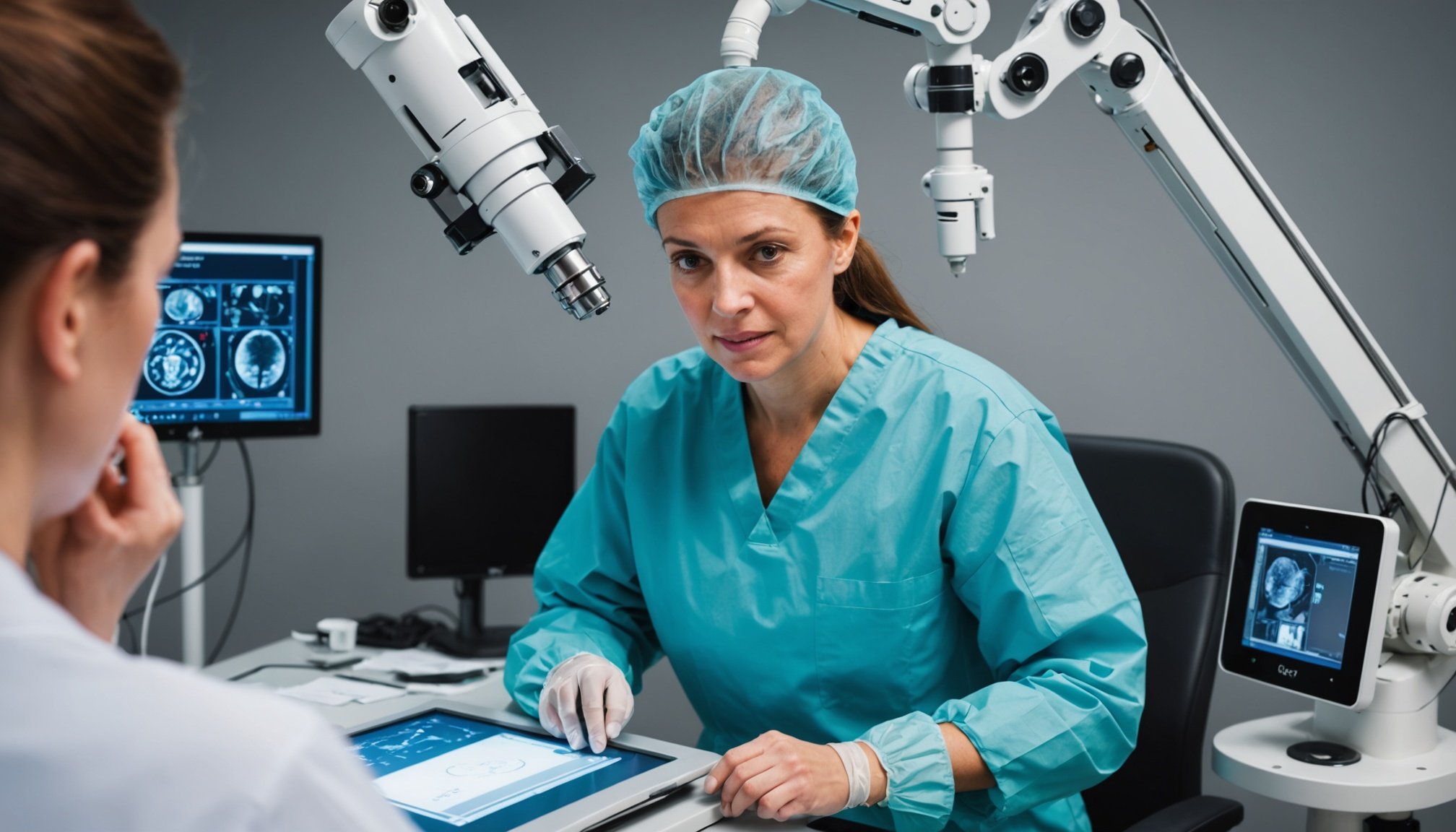Overview of Robotic Surgery in Gynecology
Robotic surgery in gynecology marks a significant advancement in surgical technology, providing innovative solutions for various procedures. Initially introduced in the early 2000s, it offers a less invasive approach compared to traditional surgery. This breakthrough technology combines robotic arms with sophisticated imaging systems, allowing surgeons to perform delicate operations with precision.
The adoption of robotic surgery in the UK has been remarkable. According to recent data, over 60% of gynecological surgeries utilise robotic systems, indicating a growing trust in this technology. The consistent improvement in patient outcomes plays a significant role in its rising popularity among healthcare providers.
Also to read : Revolutionary Approaches: Advanced Minimally Invasive Spine Surgery Techniques Employed by UK Orthopedic Surgeons
Major Robotic Systems
Robotic surgery employs several major systems, each tailored for specific gynecological procedures. Notable among them are the da Vinci Surgical System, renowned for its dexterity and precision, and the Senhance Surgical System, which is valued for its cost-effectiveness and adaptability. These systems enhance the surgeon’s capability to perform complex surgeries with increased accuracy and reduced recovery time for patients. Moreover, advancements in robotic technology continue to improve surgical efficiency, making robotic systems an indispensable tool in modern gynecology.
Challenges and Limitations of Robotic Surgery
The evolution of robotic surgery in gynecology brings significant benefits, yet it is accompanied by specific challenges and limitations that must be addressed. One of the predominant challenges is the high costs associated with acquiring and maintaining robotic systems, which can be prohibitive for many healthcare facilities. This financial aspect often raises debates about resource allocation and the cost-effectiveness of robotic interventions.
Have you seen this : Effective Non-Medication Strategies for UK Pediatricians in ADHD Management: Best Practices Unveiled
Technical challenges are inherent with any advanced surgical system. Potential complications such as system malfunctions or mechanical failures pose risks during procedures. Moreover, the technological learning curve necessitates specialized training for surgeons. Unlike traditional methods, robotic surgery requires proficiency in both surgical skills and the technology used, creating an additional barrier for widespread adoption.
The necessity for continuous updates and maintenance of robotic systems adds layers of complexity to operational logistics. Additionally, while robotic surgery enhances precision and offers visual and operational control, its adoption can limit direct tactile feedback, impacting some aspects of surgery. These challenges necessitate strategic planning and investment to ensure that robotic surgery can be leveraged effectively without compromising patient safety or incurring excessive costs for healthcare providers.
Recent Innovations in Robotic Surgery Technology
Innovations in robotic surgery are rapidly transforming the landscape of gynecology by integrating advanced technologies that enhance precision and efficiency.
Integration of Artificial Intelligence
Artificial Intelligence (AI) is revolutionising surgical practices by automating data analysis and providing real-time insights during operations. AI enables predictive analytics, improving surgical outcomes by anticipating potential complications and optimising procedural steps. This integration of AI into robotic systems enhances decision-making capabilities, offering personalised surgical plans.
Enhanced 3D Visualization Techniques
Advanced 3D visualisation technologies significantly improve surgical precision by providing surgeons with detailed views of the operative field. These techniques offer enhanced depth perception and spatial orientation, aiding in the meticulous execution of complex procedures. Improved visualisation translates to better navigation of anatomical structures, reducing the likelihood of errors.
Development of Next-Generation Robotic Systems
With the continuous evolution of robotic systems, the development of next-generation platforms brings features like refined haptic feedback and increased instrument precision. These systems focus on improving the surgeon’s sensory experience, allowing for more nuanced control over surgical instruments. Future developments aim at creating even more versatile systems capable of performing broader arrays of gynecological procedures, ultimately shaping the future of surgical technology.
Advantages of Robotic Surgery for Gynecological Procedures
Robotic surgery offers numerous benefits in gynecological practices, enhancing both procedure efficiency and patient recovery. Its minimally invasive nature ensures reduced trauma to the body, resulting in significantly shorter recovery times compared to traditional methods. Patients often experience less pain, minimal scarring, and faster return to daily activities, making it a preferred option for many.
Additionally, robotic surgery provides surgeons with enhanced visualization and control. High-definition 3D imaging grants a clear view of the operative field, allowing precise movements, even in complex anatomical areas. This precision minimizes errors, which translates to improved patient outcomes.
When comparing robotic surgery to traditional techniques, several advantages stand out. The superior dexterity of robotic systems promotes successful completion of intricate procedures that may be challenging with conventional methods. The benefits are particularly notable in surgeries where the precision of movements and control can significantly impact the results.
Ultimately, these comparative benefits highlight the value of robotic systems in modern gynecology. With continued advancements in technology, it is anticipated that robotic surgery will progressively reshape procedural standards and patient care, promoting a more efficient and effective surgical experience.
Case Studies in Robotic Gynecological Surgery
In recent years, robotic surgery in gynecology has demonstrated significant clinical applications, showing promising outcomes in various hospitals across the UK. A comprehensive analysis reveals that operations performed with robotic systems have consistently resulted in favourable surgery outcomes compared to traditional methods. Patients often experience less post-operative pain, quicker recovery, and minimal scarring, underscoring the advantages of minimally invasive procedures.
Successful Implementation Stories
Several UK hospitals have successfully integrated robotic gynecological surgery into their practice. Notably, a case at the Royal Surrey County Hospital highlighted the system’s ability to perform complex surgeries with precision and efficiency. The patient’s rapid recovery and positive feedback affirmed the system’s efficacy.
Comparative Analysis
Comparative studies reveal that robotic surgery often leads to fewer complications and shorter hospital stays. These outcomes are invaluable, especially in complex surgeries like hysterectomies, where precision plays a crucial role in success.
Patient testimonials frequently praise the technology’s role in reducing their anxiety and improving post-surgical quality of life, often mentioning enhanced comfort and satisfaction. Surgeon feedback also emphasises improved surgical outcomes and operational control, reinforcing the system’s growing acceptance in modern gynecology.
Expert Opinions on the Future of Robotic Surgery
In the rapidly evolving field of gynecological surgery, expert insights provide a valuable perspective on the transformative role of robotic surgery technologies. Leading UK surgeons, with their significant experience, offer optimistic forecasts for the future, underlining the expanding capabilities due to continuous advancements in robotic surgery.
Future trends forecast increased integration of artificial intelligence (AI) in operational decision-making processes, enhancing precision and reducing human error potential. Surgeons express that AI-driven data analytics will further refine surgical outcomes, offering bespoke patient care through personalized surgical plans.
As technologies advance, there’s considerable discourse about integrating these innovations within healthcare policies. Experts emphasize the need for updated training protocols to adapt to the sophisticated demands of next-generation robotic systems, thus preparing future surgeons.
The implications are far-reaching, anticipating changes not only in surgical practice but also in healthcare delivery models, emphasizing efficiency and patient-centric solutions. The consensus among surgical professionals is clear: embracing these technologies will indeed reshape gynecological care.
Robotic systems’ role in achieving enhanced patient outcomes while maintaining safety and precision remains at the forefront of discussions, promising significant improvements in the overall healthcare landscape.
Practical Applications of Robotic Surgery in Gynecology
Robotic surgery is transforming gynecological procedures, providing precision and efficiency in numerous practical applications. Common surgeries employing robotic systems include hysterectomies, myomectomies, and endometriosis treatment. The precision of robotic technology plays a critical role in planning and executing these surgeries with remarkable accuracy.
The impact on surgical planning is profound. Surgeons benefit from enhanced visualisation, enabling meticulous preoperative assessment and strategic manoeuvring during procedures. This leads to reduced intraoperative risks and optimised patient management, bolstering confidence in surgical outcomes.
Case examples further underscore the effectiveness of robotic systems in gynecological surgeries. In myomectomy cases, for instance, robotic assistance allows for precise excision of fibroids while preserving uterine integrity. Such cutting-edge applications improve fertility outcomes and patient satisfaction, highlighting their transformative role.
The patient experience is also notably improved. With reduced recovery times and minimal postoperative discomfort, robotic surgery patients typically resume daily activities sooner. This shift towards minimally invasive techniques underscores the significant advantages robotic systems offer in modern gynecology, ushering in new standards of care and reinforcing their essential role in current and future surgical practices.
Recent Innovations in Robotic Surgery Technology
Innovations in robotic surgery are dramatically reshaping gynecology, blending advanced technologies with surgical practices.
Integration of Artificial Intelligence
Artificial Intelligence (AI) seamlessly enhances decision-making by predicting surgical complications in real-time. Through automating data analysis, AI offers bespoke surgical plans that amplify precision. Additionally, AI’s ability to predict postoperative outcomes provides a structured approach, minimizing risks.
Enhanced 3D Visualization Techniques
Modern robotic systems benefit greatly from enhanced 3D visualisation techniques. This technology provides surgeons with superior depth perception and clarity in viewing the surgical area, allowing for meticulous navigation of complex anatomical structures. Such enhanced visualisation fosters precision and reduces the likelihood of intraoperative errors.
Development of Next-Generation Robotic Systems
The evolution of next-generation robotic systems presents features like refined haptic feedback, offering surgeons a heightened sensory experience. These advancements in robotic surgery platforms significantly increase instrument precision and facilitate diverse gynecological procedures with ease. Upcoming systems are designed to handle broader surgical scopes, solidifying robotic surgery’s integral role in modern healthcare practices.











